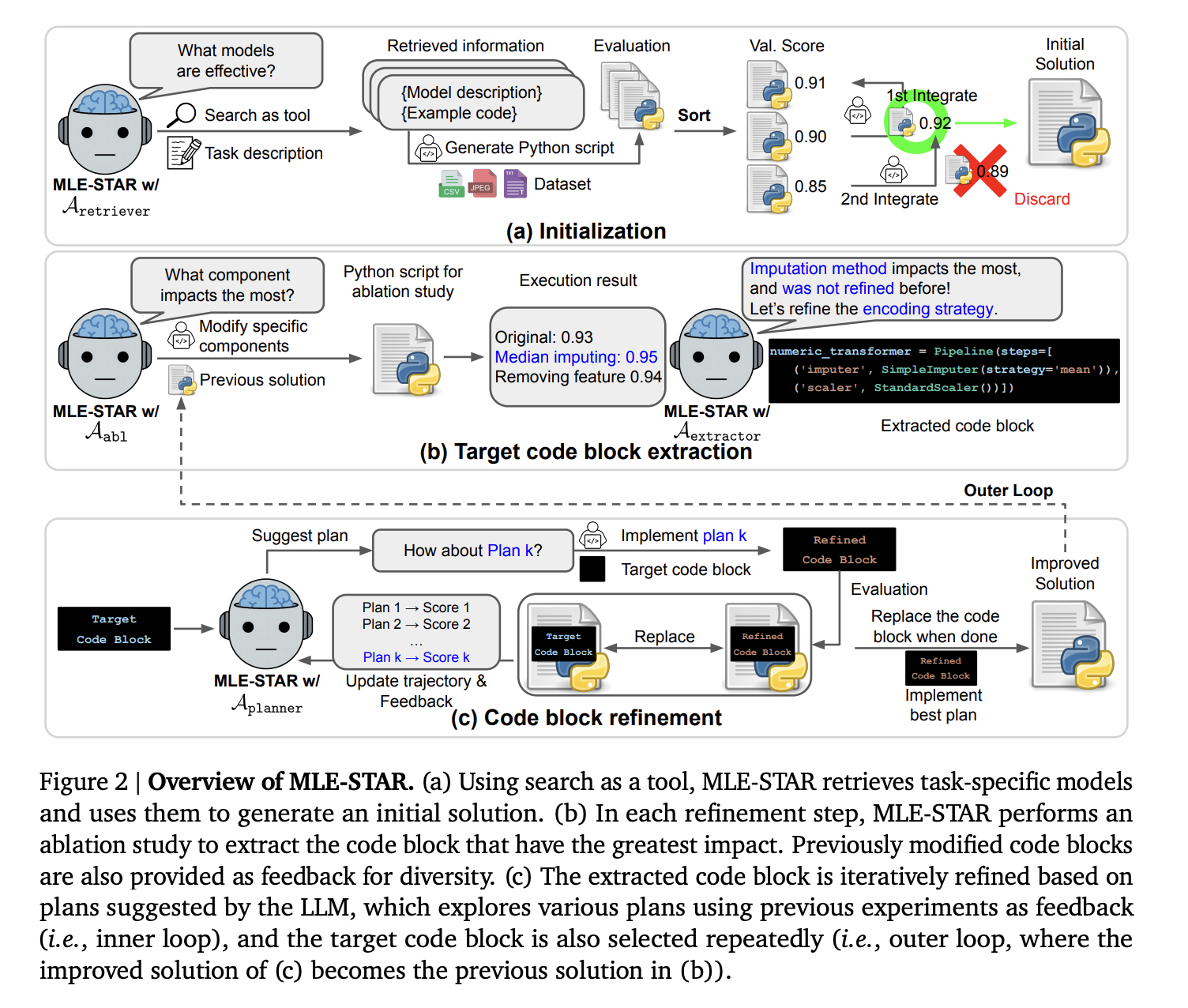August 4, 2025
5 min read
Asif Razzaq
Google AI's MLE-STAR automates complex ML pipeline design with search-guided refinement, outperforming prior agents and humans.
Google AI Releases MLE-STAR: A State-of-the-Art Machine Learning Engineering Agent Capable of Automating Various AI Tasks
MLE-STAR (Machine Learning Engineering via Search and Targeted Refinement) is a cutting-edge agent developed by Google Cloud researchers to automate the design and optimization of complex machine learning (ML) pipelines. Leveraging web-scale search, targeted code refinement, and robust validation modules, MLE-STAR significantly outperforms previous autonomous ML agents and even human baselines across a variety of ML engineering tasks.The Problem: Automating Machine Learning Engineering
Despite advances in large language models (LLMs) for code generation and workflow automation, existing ML engineering agents face several challenges:- Overreliance on LLM memory: They tend to default to familiar models (e.g., scikit-learn for tabular data), missing newer, task-specific approaches.
- Coarse “all-at-once” iteration: Prior agents modify entire scripts at once, lacking focused exploration of individual pipeline components such as feature engineering or model ensembling.
- Poor error and leakage handling: Generated code is often buggy, prone to data leakage, or neglects provided data files.
- Outer Loop (Ablation-driven): Conducts ablation studies on the evolving code to identify the pipeline component (e.g., data preprocessing, feature engineering) with the greatest impact on performance.
- Inner Loop (Focused Exploration): Iteratively generates and tests variations for that specific component using structured feedback. This approach enables deep, component-wise exploration, such as extensively testing categorical feature extraction methods instead of wholesale script changes.
- Debugging Agent: Automatically detects and fixes Python errors until the script runs successfully or reaches a maximum attempt limit.
- Data Leakage Checker: Analyzes code to prevent training bias from test or validation samples.
- Data Usage Checker: Ensures all provided data files and modalities are fully utilized, enhancing model performance and generalizability.
- MLE-STAR more than doubles the rate of top-tier “medal” solutions compared to previous agents.
- For image tasks, it favors modern architectures like EfficientNet and ViT over older models such as ResNet, leading to higher success rates.
- The ensemble strategy further boosts performance by combining winning solutions.
- Search as Foundation: Real-time retrieval of example code and model cards keeps MLE-STAR up to date with the latest model types.
- Ablation-Guided Focus: Surgical improvements focus on the most impactful pipeline components.
- Adaptive Ensembling: The ensemble agent intelligently tests stacking, regression meta-learners, and optimal weighting.
- Rigorous Safety Checks: Error correction, data leakage prevention, and comprehensive data usage lead to higher validation and test scores.
- Human experts can inject descriptions of cutting-edge models to accelerate adoption of new architectures.
- Built on Google’s Agent Development Kit (ADK), MLE-STAR supports open-source adoption and integration into broader agent ecosystems. Official samples are available here.
- AI Agents: Capabilities, Risks, and Growing Role
- AI-Driven Crypto Trading Tools Reshape Market Strategies in 2025
- The Future of Cryptocurrency Explained: What's Changing and Why It Matters
MLE-STAR: Core Innovations
1. Web Search–Guided Model Selection
MLE-STAR goes beyond internal training data by using external web search to retrieve state-of-the-art models and relevant code snippets tailored to the task and dataset. This anchors initial solutions in current best practices rather than solely relying on LLM memory.2. Nested, Targeted Code Refinement
MLE-STAR employs a two-loop refinement process:3. Self-Improving Ensembling Strategy
MLE-STAR innovates in ensemble methods by proposing, implementing, and refining combinations of multiple candidate solutions. It explores advanced strategies like stacking with custom meta-learners and optimized weight searches, surpassing simple voting or averaging.4. Robustness through Specialized Agents
Quantitative Results: Outperforming the Field
MLE-STAR’s performance was validated on the MLE-Bench-Lite benchmark, which includes 22 challenging Kaggle competitions across tabular, image, audio, and text tasks:| Metric | MLE-STAR (Gemini-2.5-Pro) | AIDE (Best Baseline) |
| ––––––––– | –––––––––––––– | ––––––––––– |
| Any Medal Rate | 63.6% | 25.8% |
| Gold Medal Rate | 36.4% | 12.1% |
| Above Median | 83.3% | 39.4% |
| Valid Submission | 100% | 78.8% |
Technical Insights: Why MLE-STAR Wins
Extensibility and Human-in-the-loop
Conclusion
MLE-STAR marks a significant advancement in automating machine learning engineering. By combining search-driven initialization, ablation-based targeted refinement, adaptive ensembling, and specialized robustness agents, it outperforms prior autonomous agents and many human competitors. Its open-source foundation enables researchers and practitioners to integrate and extend these capabilities, accelerating innovation and productivity.For more information, check out the research paper, GitHub repository, and technical blog.
Source: Google AI Releases MLE-STAR: A State-of-the-Art Machine Learning Engineering Agent Capable of Automating Various AI Tasks on August 2, 2025.

